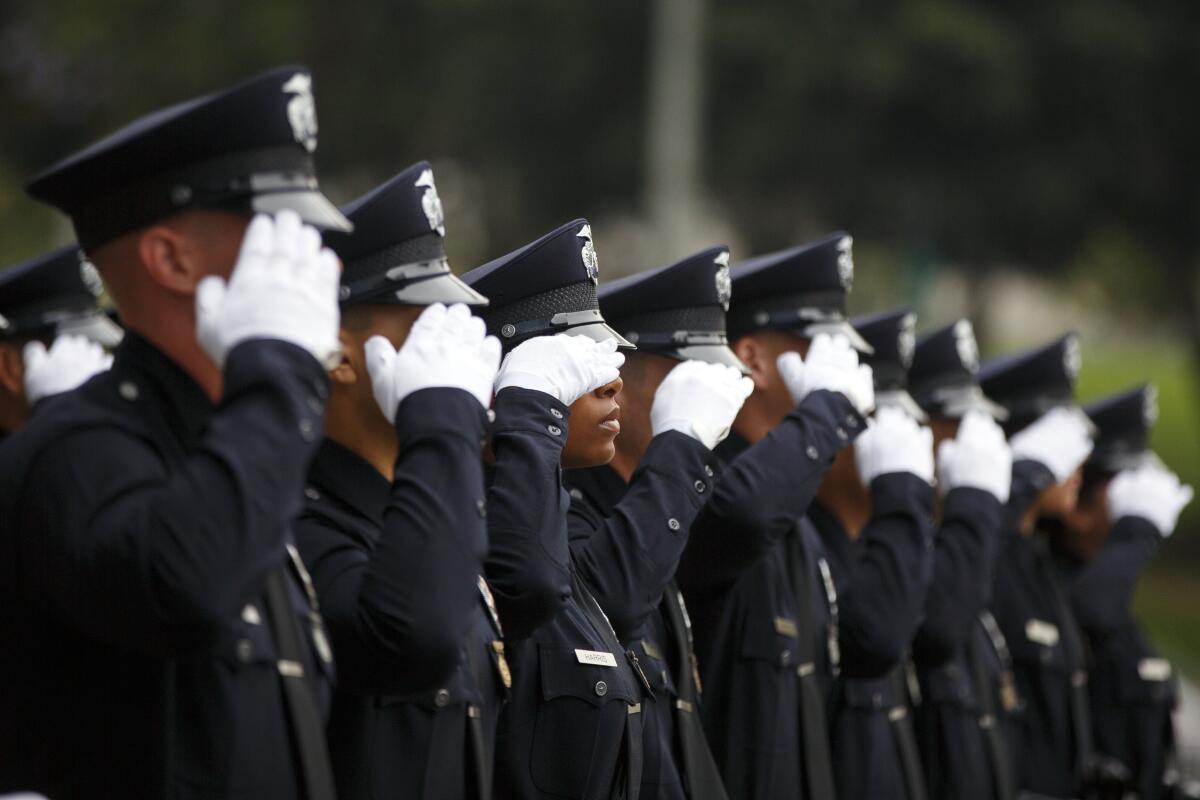L.A. Police Commission clears officers in two shootings of people in mental crisis

- Share via
Los Angeles police commissioners this week ruled that officers were justified in shooting two people suffering mental health crisises, though the group echoed LAPD Chief Michel Moore’s concerns over tactics officers used in one of the encounters.
The civilian-led panel unanimously supported Moore’s conclusions that the officers were in line with the Los Angeles Police Department’s policies on deadly force when they shot Evelyn Del Real and Grisha Alaverdyan last fall. The commission took the 5-0 vote while in closed session at the end of its weekly meeting Tuesday.
Both cases were highlighted in a Times story about the high number of people with mental illnesses who were shot by LAPD officers. The article found that about a third of the more than 30 people shot by LAPD officers in the first 11 months of last year were believed to have had a mental illness at the time.
Such shootings have fueled angry demands by critics that police no longer be sent to calls for help involving people with mental illnesses and replaced with unarmed mental health professionals.
Moore and the commission have shown an openness to the idea of partnering officers with mental health professionals, but have said that incidents involving armed suspects will always require a police response.
In these two shootings, as with others, the panel concluded that officers were responding to violent people who were threatening or hurting themselves or others in ways that required immediate action.
In the Del Real case, police shot the woman as she started stabbing her young son during a more than two-hour standoff.
The shooting occurred just before 9 p.m. on Oct. 1 inside a residence in the 200 block of West 52nd Street after police responded to a call about a woman who’d barricaded inside and was threatening to harm a child.
A redacted report released by the LAPD on Thursday said that officers watched Del Real from a window as she appeared to be using her son as cover.
The officer who fired, Juan Arenas, told investigators that moments before the shooting, he caught a glimpse of Del Real praying and then heard a scream. He said he saw Del Real swinging the knife at her son, and he shot her with his department-issued rifle, believing that she might kill or injure the boy, the report said.
Police said they had encountered Del Real previously and that she was assessed by the LAPD’s Mental Evaluation Unit. It was not known whether officers at the scene were aware of this.
The report showed that Del Real was struck twice and that the boy was also wounded by bullet fragments during the encounter — a fact that hadn’t been reported. The boy, who isn’t named in the report, was treated at a hospital for the gunshot and 10 stab wounds, the report says.
On Tuesday, the commission ruled that Arenas was justified in opening fire, while also finding that the drawing of weapons by several officers was within department policy.
But commissioners agreed with Moore in finding a “substantial deviation” from policy for the decision-making of three sergeants, who delayed in calling officers from the department’s SWAT team, which handles situations involving barricaded suspects.
In his report, the chief pointed out that during the standoff, assistance was sought from the LAPD’s Systemwide Mental Assessment Response Team — SMART, for short — which includes social workers trained in de-escalating standoffs with people thought to be mentally ill.
All of the team’s units, however, were tied up at other calls across the city, Moore wrote. The first SMART unit didn’t respond to the scene until about four minutes before the shooting, he said.
Moore promised a review of the process for dispatching SMART teams.
In a brief interview Thursday, Police Commission President Williams Briggs said that case exposed large gaps in the city’s mental health system.
“That case highlights the very real need for an expansion of the mental health evaluation units within the LAPD so that they can be more responsive to calls such as the one presented in that case,” he said.
The chief’s report also noted that after the shooting, one of the officers failed to apply pressure on Del Real’s wound, and she was left lying inside the residence in handcuffs for five minutes before officers carried her outside to an ambulance. She survived her injuries.
In the second incident, which happened a day after Del Real was shot, police shot and wounded 27-year-old Grisha Alaverdyan after he reportedly stabbed a woman on Hollywood Boulevard.
As with Del Real, police said that Alaverdyan had been previously assessed by the LAPD’s Mental Evaluation Unit — in Alaverdyan’s case, at least seven times.
Previously released body camera footage showed Alaverdyan holding up a knife as officers approached him, not far from where the stabbing occurred. A report by Moore also released Thursday said that Alaverdyan had been acting erratically, laughed and thrust his hips, even as he ignored police commands to drop the five-inch blade. Then, as he moved toward them, knife still in hand, officers shot him almost simultaneously with a live round and a beanbag projectile from about 15 feet away.
Moore wrote that while the department’s internal review board would have preferred if the officer who fired his service weapon, Thor Abiva, had waited to see whether the beanbag had any effect on Alaverdyan before shooting, but concluded he had acted to protect his fellow officers. Given the circumstances, Moore wrote, the officer’s decision to shoot was justified.
More to Read
Sign up for Essential California
The most important California stories and recommendations in your inbox every morning.
You may occasionally receive promotional content from the Los Angeles Times.














